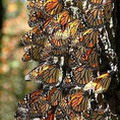 加拿大、墨西哥與美國的環境官員宣佈將共同保育帝王蝶(monarch butterfly),這種蝴蝶是整個北美洲自然環境緊密相連的最佳象徵,牠們在墨西哥度冬,在美東與加拿大繁殖,每年百萬成群遷徙往返於相隔千里的棲地之間。
加拿大、墨西哥與美國的環境官員宣佈將共同保育帝王蝶(monarch butterfly),這種蝴蝶是整個北美洲自然環境緊密相連的最佳象徵,牠們在墨西哥度冬,在美東與加拿大繁殖,每年百萬成群遷徙往返於相隔千里的棲地之間。
帝王蝶身上帶有橘黑斑紋,秋天返回墨西哥中部以後,只會選擇棲息在12個森林山區,各自形成族群,當牠們在樹枝樹幹上歇息時,會聚集成小團,總數高達數百萬。儘管目前已為帝王蝶成立了一些保護區與保留地,非法伐林仍然持續蠶食鯨吞著帝王蝶獨特、重要的棲地。
雖然帝王蝶並沒有絕種的危險,牠們穿越整個大陸、多世代的遷徙習性卻有消失的可能。帝王蝶每年是以兩、三個世代接力完成夏季北返遷徙,最後一個世代再開始南遷。帝王蝶生存所需的棲地散布在加、墨、美三國境內,因此需要三邊合作,才能保護遷徙的帝王蝶免於途中棲地破壞的威脅。
加、墨、美三國的環境官員在6月26日於渥太華舉行的會議上公佈了「北美帝王蝶保育計畫」,勾勒出各國將互相配合採取的行動。這項計畫是環境官員們在2007年的會議中,指示「環境合作委員會」(CEC)研擬發展的,目標是維持帝王蝶遷徙時的族群與棲地狀態,並且幫助墨西哥度冬棲地附近的居民之永續生活。
「環境合作委員會」是三國根據「北美自由貿易協議(NAFTA)」的環境週邊協定而簽署成立,總部設立於蒙特婁。在委員會提出的帝王蝶保育計畫中,有許多長期合作的規劃,列出近60項具體行動。
計畫內容主要針對墨西哥中南部與加州一帶的帝王蝶度冬棲地,希望能減少或停止森林砍伐行為。此外,計畫裡也詳細描述了帝王蝶的遷徙路徑、生活史與目前的保育狀態,並指出帝王蝶在各國現有管理方案下所面臨的威脅,以及一般大眾對帝王蝶的認識程度。
透過商業衛星影像,科學家在2008年春天發現墨西哥中部「帝王蝶生態保留區」( Monarch Butterfly Biosphere Reserve)出現森林棲地嚴重衰退的情形。帝王蝶保育專家布勞爾(Lincoln Brower)、斯萊別克(Daniel Slayback)與蘭蜜蕊(Isabel Ramirez)將目前與2004年的衛星影像互相比較,發現這4年來共有450公頃的森林遭到砍伐,面積約佔主要保留區的3.3%。
根據衛星影像顯示的森林衰退情形,科學家判斷未來幾年帝王蝶可能不會回到阿帕里西歐山這一帶(Lomas de Aparicio)度冬。就算帝王蝶南遷回到此地,在長達半年的度冬期間,也會面臨許多嚴重的環境危機,缺少了森林樹冠的重要遮蔽保護,冬季風暴過境的酷寒、平日太陽照射的炎熱都會威脅帝王蝶的存活。
如果墨西哥政府無法徹底落實伐木禁令,研究人員擔心帝王蝶在北美東部的遷徙、度冬現象未來可能會完全瓦解消失。
Canada, Mexico and the United States are cooperating to protect and conserve the monarch butterfly, which environment ministers of the three countries say has become a symbol of North America's shared environment. Each year millions of monarch butterflies migrate thousands of miles back and forth from wintering grounds in Mexico to their breeding locations in the eastern United States and Canada.
In the fall, the orange and black monarchs return to just 12 forested mountaintops in central Mexico, where they form colonies in which millions of butterflies cluster on the trunks and branches of the trees. Despite the creation of protected areas and reserves, illegal logging has been shrinking this unique, critical monarch habitat.
Although the monarch butterfly, Danaus plexippus, is not in danger of extinction, its unique multigenerational migration spanning the continent is considered an endangered biological phenomenon. Monarchs have up to four generations each summer, each one traveling a little further north than the last. The last generation of the year migrates south. Because monarchs depend upon a wide range of habitats in Canada, Mexico and the United States, conservation of the migratory monarchs requires trilateral cooperation due to threats to the butterflies' habitats throughout the flyway.
The North American Monarch Conservation Plan, announced Thursday by the environment ministers of the three countries at their meeting in Ottawa, outlines concerted actions to be taken in each country. At their 2007 annual meeting, the ministers instructed the Commission for Environmental Cooperation, CEC, to develop a North American plan aimed at maintaining healthy monarch populations and habitats throughout the migratory flyway, while promoting sustainable local livelihoods in the wintering grounds in Mexico.
Based in Montreal, the CEC is an international organization created by the three countries under an environmental side agreement to the North American Free Trade Agreement. The CEC monarch butterfly conservation plan outlines a long-term collaborative agenda with nearly 60 specific actions.
It is aimed decreasing or eliminating deforestation in the overwintering habitat in south-central Mexico and California. The monarch conservation plan, in addition to the actions it outlines, provides a detailed overview of the monarch's migratory patterns, lifecycle and its current status. The plan also identifies the main threats to the monarch set in the context of current management actions taken in each country, as well as public perception of the species.
This spring scientists identified severe degradation of the forest habitat within the Monarch Butterfly Biosphere Reserve in central Mexico, using imagery from the commercial Ikonos satellite.
By comparing satellite images from 2004 forward to the present, monarch butterfly specialists Lincoln Brower, Daniel Slayback, and Isabel Ramirez have determined that 450 hectares (1,110 acres) of forest were logged between 2004 and 2008, representing 3.3 percent of the 13,552 hectares (33,410 acres) core zone of the reserve.
Based upon the degradation apparent in these images, it is unlikely monarchs will form overwintering colonies at this Lomas de Aparicio site in future years, the scientists say. If they do return, they will be subject to much greater environmental risks during their six-month overwintering stay. An intact forest canopy serves a critical role by protecting the monarchs from both freezing cold during winter storms and from excessive warmth during the days.
The researchers are concerned that the entire monarch butterfly migration and overwintering phenomenon in eastern North America may collapse in the near future if the Mexican government does not fully enforce the logging ban.
The North American Monarch Conservation Plan is online at: www.cec.org/monarch. An interactive Google Earth map of the monarch butterfly's range, along with those of 34 other species of common conservation concern, is at: www.cec.org/naatlas
※ 「北美帝王蝶保育計畫」網站
※ 顯示帝王蝶分佈範圍的Google Earth互動地圖(包括其他34種保育關注的物種)
全文及圖片詳見:ENS



